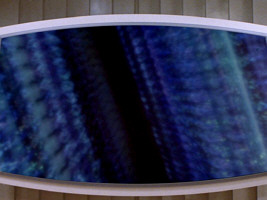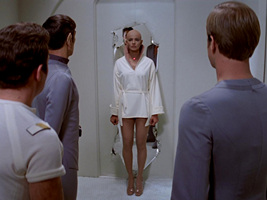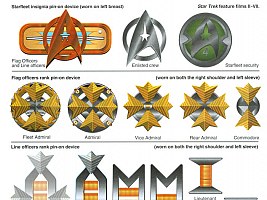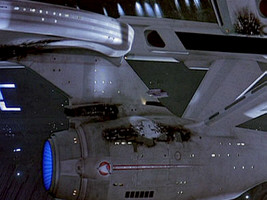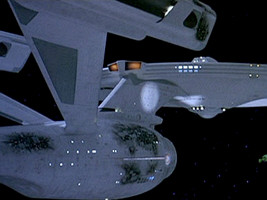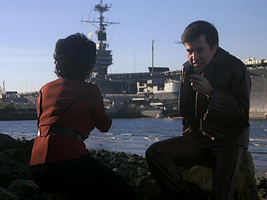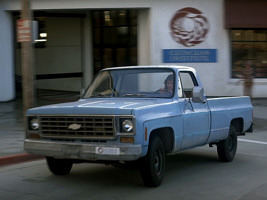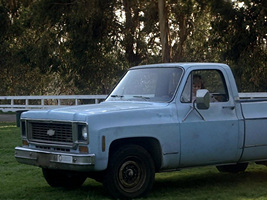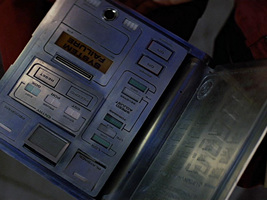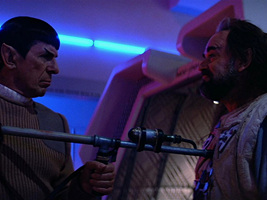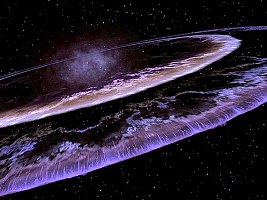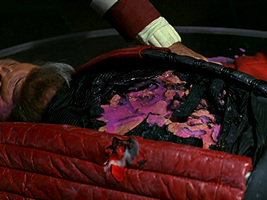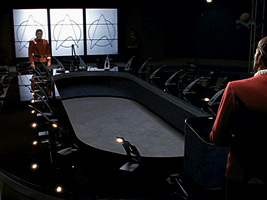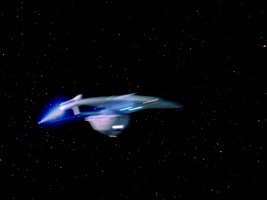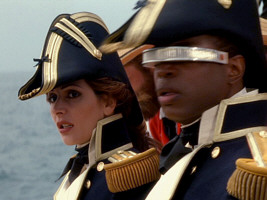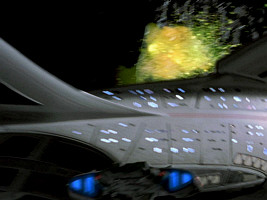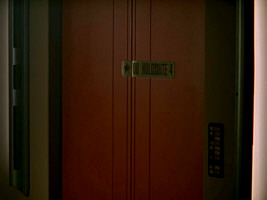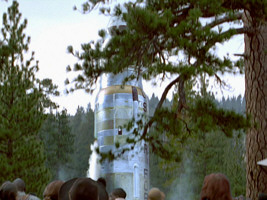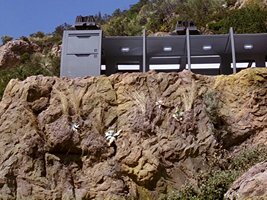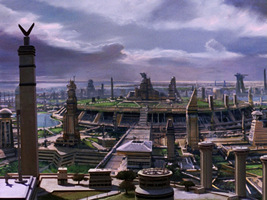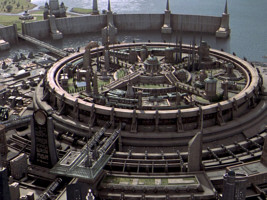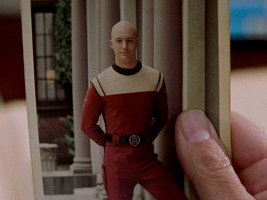Movie Inconsistencies
Star Trek IStar Trek IIStar Trek IIIStar Trek IVStar Trek VStar Trek VIGenerationsFirst ContactInsurrection Nemesis
Star Trek: The Motion Picture
- "Vulcan has no moon." This is what Spock told Uhura in TOS: "The Man Trap". Yet, in the movie's kolinahr scene two enormous celestial bodies are visible in Vulcan's sky. Obviously someone noticed this apparent error, and for the Director's Cut DVD a completely new Vulcan landscape with huge statues and without celestial bodies was created, one that is also closer to the original sketches for the movie.
- Why do the Klingons suddenly have ridges on their foreheads in TMP? This question troubled generations of fans. But it was never even supposed to be asked, for it was commonly retroactively explained as a make-up shortcoming of TOS. The real Klingons were said by Gene Roddenberry to have always looked as in TMP. In DS9: "Trials and Tribble-ations" the difference is explicitly hinted at, however. And ultimately in the Klingon double feature ENT: "Affliction", "Divergence" the smooth forehead of the TOS era is explained as a mutation because of tampering with Augment genes.
- The Enterprise's transporters are not working, and hence Scott takes Kirk on a shuttlepod ride from the orbital station to the ship. But couldn't they simply use another transporter to beam personnel directly to the ship? It may be possible that safety regulations require two transporters to be involved though, unless a landing party beams down to or up from an undeveloped planet.
- Decker tells Kirk, "Admiral, this is an almost totally new Enterprise." And this is true. The Enterprise in this movie is evidently not the same ship as the one of TOS. While the core of the Enterprise may still be the same, most of its surface has to be completely new, because of the different proportions. There are precedents in real life that warships were rebuilt in a way to only resemble their original appearance. Still, it is hard to believe that Starfleet would literally rip apart the complete ship, which seems to be just the same or even more effort than building one from scratch.
- At the time of TOS, every starship had its individual badge, the one of the Enterprise being the arrowhead. But in TMP all Starfleet Personnel that we see on Earth (not those at Epsilon IX though) sport the arrowhead too. The following films and ultimately TNG will make clear that the arrowhead has indeed become the general symbol of Starfleet.
- Kirk tells Scott that the alien machine is three days away from Earth, and that "the only starship in interception range is the Enterprise". In other words, Starfleet has nothing within three days of Earth, the center of the Federation, or within three days of that machine if you will, than a barely operational ship that needs to be launched prematurely, with untested warp engines! It doesn't really become more realistic in retrospect considering that several later Trek movies will use the same lame excuse for the Enterprise being the only ship to deal with someone or something.
- Quite unlike the Enterprise of TOS, the new TMP ship has a warp reaction assembly that is several decks high and that would set the standard for all Federation ships to appear in the later series and movies. On the other hand, we may pretend that we simply haven't seen this very part of the ship in TOS that was apparently located close to but not directly inside the main engineering area. And regarding the consistency, even during TOS the location of the dilithium chamber as the main power generator was subject to vary.
- The diameter of the cloud is stated to be as much as 82 AUs, and as such it would envelop the whole solar system and possibly push planets out of orbit (although the solid machine inside is still small enough to orbit Earth). The diameter was later revised to more realistic 2 AUs in the Director's Cut.
- When Epsilon IX is being attacked, Kirk orders the viewer on the recreation deck to be switched to external view. While we are shown the destruction of Epsilon IX from different "impossible" angles, we can surmise that the viewer may have shown something more realistic to the crew during that time, as recorded by a camera on Epsilon IX. At the end however, the station is gone and there is still an external view on the screen, showing only the alien machine, although there should be nothing such as a camera left.
- "My oath of celibacy is on record, Captain." Ilia's statement, as well as the amazement of the crew to her being Deltan, is out of place. It doesn't make any sense considering that we learn nothing about the Deltans in the movie, except that they can somehow take away a person's pain. And even if we take into account that Deltans, with their "highly developed sexuality", as described behind the stage, have a distracting influence on the rest of the crew, it is still inappropriately sexist to require or only expect an oath of celibacy from them.
- Kirk says "we must now risk engaging warp drive while still within the solar system." This is one of a couple of instances where going to warp inside a solar system is considered unsafe, while on most other occasions it was no problem at all, including directly warping into and out of orbit. But rather than this being a general problem, Kirk may have deemed it risky with the ship's untested warp engines. And indeed, as Scott reports, "it was an engine imbalance that created the wormhole in the first place."
- When Kirk is returning from the lounge and taking place in the center seat again, the ship is already at red alert. But as Decker explicitly states a few seconds later, the "screens and shields" have not yet been raised (and Kirk orders to keep them down, because it could be misinterpreted as hostile). This is in contrast to numerous other situations, in which red alert includes the raising of the shields (which is usually the least to be done in case of an impending battle).
- This movie has quite a confusing and hence illogical variety of names for the ship's defensive measures. There are initially "screens" and "shields", later "deflectors" and "forcefields", all of which would realistically denote just two distinct systems altogether.
- We see only in a split second how the Ilia probe punches a hole into the sickbay door. When the camera is on her again and she steps through the hole, there should be either large chunks of metal pointing outward, or an according amount of debris on the floor, but there is neither of that.
- Curious as they are, the machines on that planet took all the effort of finding out about the probe's origin and building a huge vessel around "V'ger", but they didn't even clean the probe, which would have revealed its full name? And even if removing the dirt was considered unnecessary, wouldn't it have been easy to scan through it to find the whole name?
- Decker says that the probe Voyager VI (that doesn't exist in the real world) was launched from Earth more than 300 years ago. But that should be "almost 300 years", considering that Voyager 1 and 2 were launched in 1977 and the movie takes place in 2271 (or 2273 according to a slightly revised history).
- V'ger is supposed to receive a binary code from the Enterprise, but what Decker reads out is all decimal. Well, it could be a BCD code, although I doubt that with its unused codes (6 per 4 bits) it would have been used for an interstellar probe.
- Where does V'ger/Decker vanish in the end, without destroying Earth's surface? It must have been something like a parallel dimension.
- At the end, in one take, McCoy and Spock have switched their uniform jackets.
Star Trek II: The Wrath of Khan
with supplements by DAS
- Saavik identifies the position of the Enterprise as "Gamma Hydra, Section 14". The captain of the Kobayashi Maru reports that his ship is in Section 10, which Saavik quickly recognizes as being already in the Neutral Zone. I am not aware of any other Trek installments referring to "sections" as spatial coordinates.
- After Saavik's decision to aid the Kobayashi Maru it takes no longer than six seconds from Sulu's course change to his announcement that the Enterprise is just entering the Neutral Zone. This may be feasible at high warp speed, knowing that the ship has been on a course along the Neutral Zone anyway. However, barely 40 seconds later the Klingons are already firing torpedoes. (Scene continuity requires that everything takes place in real time.) By all means, the Klingons could never have set up such a precisely timed trap. The huge coincidence of running straight into three Klingon battlecruisers in the vastness of space can hardly be a realistic simulation. It was meant to be a no-win scenario anyway, but with three Klingon vessels appearing out of nowhere Saavik has every right to criticize the Kobayashi Maru test as unfair.
- It also unfair that the simulated Enterprise is dead in the water after just a few shots, unlike the real ship that will take a lot of beating in this and the next movie.
- Saavik orders to activate the escape pods. There are more reasons why escape pods must exist, although nothing like hatches to that end are visible on the ship's hull.
- A sign on the wall of the bridge simulator says "No smoking at any time on the bridge". It is clearly legible. Still, it must be an in-joke. Although everyone was still smoking in 1982 when the movie was made, in Starfleet no one ever smokes. I wonder if the people of the 24th century even know what smoking is (and particularly what the stench is like). Purportedly Nicholas Meyer wanted the no-smoking sign (and hence the characters to smoke at least occasionally). Fortunately, after Roddenberry's veto, it was included just in the simulator room.
- The red "Exit" sign of the simulator room is clearly a 20th century US model. There is no reason why the standards for exit markings could not be the same in the 23rd century Federation, but anything in any way different may have looked more realistic. In the European Union, for instance, pictograms show the way to the exit, which even aliens would be able to comprehend.
- A sign on the exit door reads "Mark IV Simulator - Enterprise Class". There is no real reason why a so named class should not exist, although it is often contested considering that the Enterprise should be still a Constitution-class (refit) vessel.
- Why did Spock never take the Kobayashi Maru test? In the movie the test comes across as customary, and perhaps required to command a ship.
- The simulator scene seems pretty dangerous for cadets to be practical. Would they really consider using charges and explosions for training purposes?
- It should be "Alpha Ceti VI", not "Ceti Alpha VI".
- The science officer of the Reliant reports that Ceti Alpha VI (or what he thinks is this planet) has a "limited atmosphere, dominated by craylon gas, sand, high-velocity winds -- incapable of supporting lifeforms." If the atmosphere is really *dominated* by the exotic craylon gas instead of nitrogen, it is doubtful that human beings could survive there the way we see later (Khan and his people may have breathing apparatuses but definitely no functional airlock). So most likely the statement is just very imprecise, and he actually means that there are considerable amounts of that gas besides nitrogen and oxygen.
- "I never forget a face, Mr. Chekov." -- No review of this movie could be complete without a note on this famous continuity riddle, although we are able to explain it away in a way that Khan may have encountered Chekov off-screen.
- The metallic Starfleet arrowhead that Khan is wearing as a necklace is very similar to the current version on Starfleet uniforms at the time of the movie (2285). Where could he have got it? The TOS version used to look very different, and even the TMP badge was typically still made of fabric. It must be some sort of ornament that was ahead of its time for some reason when Khan was exiled to Ceti Alpha V in 2267. But what kind of equipment would Starfleet decorate with metal emblems? One possible explanation is that the arrowhead belonged to his presumable wife, ex-Starfleet officer Marla McGivers. The explanation attempt that Khan took a buckle from Terrell or Chekov does not work out. After apprehending the two officers, should he take off his coat in the sand storm just to put on the trophy, especially since he was going inside anyway?
- While schematics of several different vessels are visible on both ships, it is odd nonetheless that there are deck plans of the engineering hull of the Constitution class on the Reliant all the time.
- The explosion of Ceti Alpha VI shifted the orbit of Ceti Alpha V so it became a wasteland. But could the two planets have been so close together that this was possible? Also, even if the explosion was never registered, shouldn't Starfleet have kept a record on this previously charted star system, which would have made it possible to identify the planet Ceti Alpha V regardless of the existence of Ceti Alpha VI? Starfleet as a scientific organization should really rely on more than just planet counting.
- Khan says, "On Earth, two hundred years ago, I was a prince." But actually that was more like 300 years ago (1996) according to the other accounts in the movie (although we may decide to postpone Khan's time in the light of other evidence).
- Spock and Kirk both routinely address Saavik as "Mr. Saavik". While this may be according to protocol in the late 23rd century, it is still uncommon.
- "One quarter impulse power" is extremely slow in this movie, at most ten meters per second after several seconds of acceleration. With the scene of the Enterprise leaving the drydock being stock footage from "Star Trek I", the error lies in the script.
- Dr. Marcus receives a call from the Reliant over a "hyperchannel", something never heard of again in Star Trek. It must be an obscure term for "subspace radio".
- Regarding the aptness of a planet for the Genesis device, Dr. Marcus insists that even microbes could jeopardize the experiment. Why does the crew of the Reliant even consider Ceti Alpha V/VI, a planet that may support life, if only barely? Why not test the device on the completely dead Regula asteroid, where the underground phase takes place anyway?
- When he has just received order to take care of Regula 1, Kirk explains to Spock (not for the first and not for the last time in Star Trek), "We're the only ship in the quadrant." First off, "quadrant" needs to be substituted with "sector" here because at the time of "Star Trek II" the redefinition of galactic partitions has not yet taken place. Still, it would be an extremely unlikely coincidence if Kirk, the man who Khan wants to take revenge on, were accidentally on the ship that is the closest to the scene. Actually Khan attempts to lure Kirk to Regula to intercept him, when he has Chekov contact Marcus, pretending that Kirk wants the plans for Genesis. It would be absolutely plausible if Starfleet ordered Kirk to investigate the incident, or if Kirk himself took the initiative. So why the awkward justification of the new orders for the Enterprise that either Kirk himself or Starfleet must have made up? Actually, not the Enterprise but the Reliant would be the closest ship from Starfleet's viewpoint.
- Khan says about Kirk: "I'll chase him 'round the moons of Nibia and 'round the Antares Maelstrom and 'round perdition's flames before I give him up." This is an "updated" version of a Captain Ahab quote from Moby Dick. There is no doubt that Khan has read the novel attentively, which Chekov spots on a shelf inside the Botany Bay. He also cites the words "From hell's heart I stab at thee; for hate's sake I spit my last breath at thee." But would a human from the 20th century refer to or even know about the places in deep space? Also, what could the Klingon proverb "Revenge is a dish best served cold" signify to him, when he has never even seen Klingons? Marla McGivers may have told him a lot of things and thanks to his "superior intellect" he may remember much of what he read aboard the Enterprise. Still, the universe of the 23rd century is not the realm of experience that he would likely cite from.
- When the Reliant approaches the Enterprise and no communication can be established, Saavik reminds Kirk of General Order 12. While she does not have the chance to finish the sentence, this regulation must be about raising the shields. Why in the world does Kirk not follow the order? His foremost duty is to ensure the safety of the ship - a ship full of kids in this case. But Kirk's order to raise shields comes as late as Spock reports that the Reliant is locking phasers!
- The display showing how the defense fields of the Enterprise are being activated reads "Intruder alert". While the defense fields, as opposed to the shields, are probably meant to block unwanted beaming, "intruder alert" realistically still signifies that an intruder has already been discovered, which is not the case here.
- The ships fire pulses in this movie, not the continuous beams that are otherwise typical of phasers.
- After the first phaser barrage on the engineering hull, Spock's viewscreen indicates damage on the saucer, although the Enterprise hasn't been hit there.
- When the Reliant is passing the dorsal saucer hull of the Enterprise, she casts a shadow, although the encounter supposedly takes place in open space.
- Why does Scotty bring the seriously injured Preston all the way up to the bridge, and not directly to sickbay? He wastes precious time for nothing but the melodramatic impact.
- After he and Terrell have been discovered on Regula, Chekov tells exactly what happened, even the worms, and no one believes them! McCoy is even standing right behind him, and doesn't bother to scan him.
- When Captain Terrell attempts to defy the influence of the Ceti eel in his brain, he sees no other chance than to commit suicide. Chekov, in a similar situation, evades madness and death because the creature conveniently crawls out of his ear.
- Without knowing what it actually is, Kirk vaporizes the Ceti eel that crawls from Chekov's ear. Clearly he is aware that the creature is dangerous. But killing new lifeforms is not really the Starfleet way.
- Where is torpedo bay 4? It is shown during the preparation for the final battle with the Reliant, using the same set as torpedo bay 2, the one next to the port docking hatch. If bay 4 were anywhere else on the ship but in the neck, it would clearly look different.
- In order to repair the warp drive and save the ship, Spock is tinkering with a heavily radiating chamber that must be a crucial part of the power system but will never play a role on any Federation ship again.
- Why does Spock have to sacrifice his life, rather than anyone else? Sure, he may know best what he has to do to clean the manifold or whatever it is. Still, someone of the engineering crew may have done the dirty work.
- The Genesis device explodes in a huge plume of fire. But if it just converts the matter of the Mutara Nebula, how can a planet be formed out of it? Even though it is nearly omnipotent anyway, the matrix was definitely not configured to accomplish that, as it was supposed to be detonated on an already existing planet. Rather than that, the explosion encompasses the Regula asteroid, which is then transformed to a planet. And unless a star with the appropriate radiation spectrum is coincidentally at the right distance from the explosion (which is exceedingly unlikely), the Genesis device even creates a sun!
- When Spock's coffin is launched, it is torpedo bay 2 on the inside, the one next to the port docking hatch, but it is the starboard launcher as seen from outside. Since the port launcher was completely destroyed during the battle in the Mutara Nebula, using the starboard launcher makes a lot more sense, only that the interior set should have been flipped and accordingly relabeled to that end.
- How can Spock's coffin safely land on the Genesis planet, totally unscathed and like it has just been polished? Is the torpedo coffin equipped with a heat shield and thrusters?
Star Trek III: The Search for Spock
with supplements by DAS
- In the opening scene we can see "stars" come about the Enterprise. This phenomenon is hard to justify, unlike the "star streaks" that are often visible from inside a ship. Realistically the ship would have to move across an almost fixed star background.
- At the end of "Star Trek II: The Wrath of Khan" we can see several scorches from the battle with the Reliant on the Enterprise's hull. All of them are on the port side, on the lower saucer, the torpedo bay and upper forward engineering section. In the opening scenes of "Star Trek III" in space and in the spacedock, however, there are many more burns, like on the nacelles, on the top of the saucer and most obviously on the starboard side which was still undamaged in "Star Trek II". What happened? Did Kirk pick a few more fights on his way home, with his damaged ship and inexperienced crew? After the Reliant's very first attack run in "Star Trek II" Spock shows Kirk a diagram with a damage report, where red lights are flashing on the starboard side too. This insinuates that the phasers themselves or explosions inside engineering have damaged the starboard hull. This may explain some of the scorches in "Star Trek III". Still, no damage at all is visible on that side throughout the whole movie "Star Trek II".
- When Chekov detects the energy readings from Mr. Spock's quarters, he is looking at deck plans of the pre-refit Enterprise.
- Why should Spock's quarters be sealed and marked with a yellow tape? Is anything in there that would suddenly become contagious or otherwise hazardous after his death, or is Kirk afraid that the crew may be keen on stealing Spock's belongings?
- Admiral Morrow says, "The Enterprise is 20 years old". This is wrong, if we assume that she is still the same ship that Captain Pike commanded some 30 years ago. The refitted version, on the other hand, is barely 15 years old at the time of the movie.
- Kirstie Alley did not reprise her role as Saavik and was replaced with Robin Curtis. But why was no attempt made to let Curtis appear at least a bit like her predecessor? With her curly hair and especially the pointed eyebrows she couldn't possibly look more different.
- "Star Trek III" provides a reason why the torpedo casing with Spock could make a soft landing, because the "gravitational fields were in flux". But how could they, considering that the planet's surface had already consolidated with large forests and other vegetation? If the planet had really been subject to considerably varying gravitation, it should have been accompanied by lots of volcanic activity that would likely have destroyed the coffin after the landing.
- Kirk and Sarek review the "flight recorder visuals" of Spock's last minutes. All this is naturally stock footage from "Star Trek II" and not anything like an automated recording, because it includes pans and different camera positions. There might be an "intelligent" software to auto-edit the scene the way a human viewer would likely want to see it. But considering that Kirk is looking for specific details, wouldn't he rather want to review the raw unadulterated data? Or perhaps a permanent close-up of Spock's hands?
- The microbes in Spock's torpedo coffin are quickly evolving to huge worms on Genesis. Which special condition on the planet caused by the Genesis effect could enable a fast evolution, unless time itself were accelerated there? The sunset is very fast, but hardly because of the Genesis effect. However, the seasons or the climate are changing quickly as well. If an evolution had taken place, it would have required the animals to procreate, to spread out and to adapt over hundreds or rather thousands of generations, and not to slowly crawl around the coffin all the time. So the probably best justification is that the Genesis effect evokes continuous mutations in a few generations or perhaps just one.
- Why is Spock aging so quickly on Genesis, but not anyone else? Shouldn't he rather "evolve" like the microbes in his coffin? On the other hand, the trees on Genesis have grown extremely fast too, and this was the intention of the inventors. McCoy later states that "all genetic functions [in Spock] are accelerated." As aging is at least partially a genetically determined process, this is half-way plausible. In some odd fashion Spock, although not originally part of the Genesis matrix, must have been "encoded" in some way to grow up quickly.
- Still, if we can explain Spock's aging process, isn't it in strong contrast to the initial resurrection and rejuvenation of his body? How could Spock's body be reanimated in the first place? David Marcus theorizes that the Genesis wave could have regenerated his cells. He and his mother previously stated about the Genesis effect that it would destroy every existing lifeform and create new life out of the matrix. They may not have taken into account that, after the elimination of all old life and before a "safe" period in which the planet would be inhabitable without side effects, a lifeform coming from outside could be subject to the effect as well. Still, it does not make much sense that Spock is first reanimated and then grows up quickly.
- Why does Kirk need the Enterprise of all starships to return to Genesis? Also, did he really expect that he and the mentally inhibited McCoy could operate the battle-damaged ship all alone, after just a bit of tweaking by Scotty? (He seriously wanted to dismiss Scotty, Chekov and Sulu.) Stealing a smaller vessel or hiring a ride outside the Sol system would probably have been a lot easier.
- It looks like the saucer of the Enterprise barely clears the space doors. The Excelsior, which is still wider, follows through the same gate without any trouble.
- Captain Styles orders "one quarter impulse" inside spacedock. Does he want to smash the ship? As usual, we have to explain this command in that it implies slowly powering up the engines to a final speed of one quarter impulse.
- David Marcus tells Saavik that he used unstable protomatter for the Genesis device, which he believes is the reason why the planet is breaking apart. Whilst this objectionable approach is a part of the story, wouldn't it be a much more plausible explanation for the failure that the Genesis device was in no way designed to detonate on a starship far away from a planet?
- Kruge is the only Klingon we know is addressed as "my lord". He may have demanded that from his crew and from Valkris. But why does Saavik say "my lord" on their very first encounter too? I doubt that she speaks Klingon and could have picked up the Klingon equivalent of the word "lord" when Kruge's people were talking.
- Sarek speaks to Kirk about taking Spock's katra as well as his body to Vulcan as soon as in the beginning. This is at a time when he cannot yet know that his son's body has been revived on Genesis. Sarek says that mind-melding (and hence the katra transfer) is "the Vulcan way when the body's end is near." So what would normally happen to the living katras of dead Vulcans? Certainly the katra would be transferred from someone else's mind to some other place on Vulcan. Do dead Vulcans live on in a non-corporeal state? Then what would the dead body still useful for that Sarek insists on being taken to Vulcan, if he did not intend to recombine it with the katra? As the high priestess says in the end when Spock's body is taken to Mount Seleya, fal-tor-pan, the procedure of reverse katra transfer, has not been performed in ages. So this cannot be the normal course of action, which remains completely nebulous (at least until recently when the Vulcan arc in Enterprise sheds some new light on the issue).
- The first thing that Spock recalls from his former life is: "I have been, and always shall be, your friend. Is the ship out of danger?" Spock said exactly that to Kirk just before he died in "Star Trek II". But he spoke the words when he had already transferred his katra to McCoy. Assuming that Spock's memory was likely wiped when he died it is odd that the reintegrated Spock could remember these of all sentences he ever said.
Star Trek IV: The Voyage Home
- In the beginning, the Federation Council, in the presence of the Klingon ambassador, watch the recordings of the last few minutes of the USS Enterprise and its destruction at the Genesis planet. Naturally everything on the viewscreen is stock footage from "Star Trek III". But how can it be that the ship's explosion has been filmed from the outside, even from different angles? By all means this is impossible. Even if the footage were authentic, the way it is edited (like what it actually is, a movie) to be presented at the Council makes it anything but reliable evidence in Kirk's case.
- The Federation Council is much more than just cowardly polite to the Klingon ambassador with his absurd claims and overt insults. Never once his speech is interrupted by anyone of the dozens of attendees. Even worse, the Council seems to be opposed to Sarek's statements about "Klingon justice". We can't actually understand any words, but instead of applause or only silent approval for his correct remark that the Klingons murdered the crew of the Grissom they instantly engage in a chaotic debate whereupon the President has to call for silence. Although Sarek's appearance may have been against the protocol, his own people effectively deny him any support.
- The size of the very same Klingon Bird-of-Prey, the HMS Bounty, is subject to vary considerably, not even relative to "Star Trek III". At the beginning of "Star Trek IV", on Vulcan, the ship is barely 50m long, whereas it grows to some 200m width compared to the whaling ship in the end.
- The bridge of the Klingon vessel (image of previous configuration) was completely rebuilt. Kruge's "throne" was removed, all stations re-arranged, and even the floor and the walls were moved. We may assume that the refit was necessary because of battle damage, but we can't assume that the Vulcan engineers or Scotty would have the expertise to do that or would even have another Klingon bridge readily available. As Scotty himself says, "Reading Klingon is hard", suggesting that there are already problems to decipher the manuals for the ship in its current configuration. If we nonetheless insist on them rebuilding the bridge, why are all controls in "Star Trek IV" still in Klingon? The only way for it to make any sense is that the bridge in "Star Trek IV" is actually an auxiliary control room.
- Spock says, "I seem to have misplaced my uniform," when he enters the bridge in his Vulcan gown. If this really poses a problem, couldn't he find any more suited clothes on the whole planet?
- How can sound travel through space, assuming that the whale probe is in orbit and its transmissions are sonic, as confirmed by Uhura's modification of the signal to sound like under water?
- The cargo bay on the Bounty is 60 feet long, according to Scotty. He seems to have misplaced his knowledge of SI units. He may have been preparing for his journey to the 20th century though (which is always the same preparation as the crew always winds up in the USA).
- It may seem like a minor point, but isn't it incredibly ironical that there are glass windows in Starfleet Headquarters? One of them is shattered just while Kirk is speaking over the comm system. It is a plain glass window, no security glass, no plexiglass, let alone transparent aluminum.
- Along with the ship's mass through the time continuum, Spock mentions the probable location of humpback whales (in the Pacific Ocean) as one of the variables he programmed from memory for the time warp. What does this have to do with the calculations for the time travel? Once they are some time in the late 20th century, wouldn't they simply scan the planet until they find some whales? Which is exactly what Uhura will do.
- Spock speaks of capturing high-energy photons (apparently gamma radiation) from a nuclear fission reactor to recrystallize the dilithium crystals. It is, however, paradoxical to store photons because they only exist when energy is released as radiation. Spock explains that he will construct a special device for that purpose, but explicitly to contain them because of their "toxic" nature, not to preserve them in the first place.
- The cloaking effect of the Bounty extends exactly to the boundary of its hull. This can't be a field of any kind, it looks like a change in the ship's atomic structure, unlike everything we learn elsewhere about Trek's cloaking devices.
- After leaving the Cetacean Institute in Sausalito, at the northern shore of the Golden Gate, we can see Kirk and Spock take a walk on the opposite shore, in the area of the Presidio near Fort Point. But there is no direct way from the Golden Gate Bridge down to that area, at least not for cars, and it takes quite some time to get there on foot. Why should the two take such a detour, just for some sightseeing? Moreover, what the hell, to use a colorful metaphor, is Gillian Taylor doing there, apparently on her way home from the Institute? They obviously didn't have an appointment. Agreed, Gillian may have been seeking Kirk and Spock out of curiosity, but it is an incredible coincidence that she would find the two miles away from the aquarium on the other side of the bay. Later, at the dinner, Gillian mentions that Kirk "couldn't even find the way from Sausalito to San Francisco without getting a lift". This is wrong because they were close to the city center when she met them, although it is just on a humorous note.
- Well, the ship that Chekov finds is not the USS Enterprise CVN-65 but the USS Ranger CV-61 (and actually not a "nuclear wessel").
- At Plexicorp, after talking into the mouse in vain, Scotty manages to create complex graphics just with key clicks. Even if the Apple software of the 1980s had allowed to work like that and even if Scotty really knew how to handle the software and a keyboard (which doesn't seem to exist in his time), this is simply impossible.
- Taking a ride on a fork lift is strictly forbidden under job safety regulations. Even if it happens as long as no one from outside the company is watching, the Plexicorp manager would least of all offer this means of transportation to a valued guest like "Professor Scott".
- The crew are careless all the time, because any tiny intervention could have an unpredictable impact on the future. But disclosing the secret of transparent aluminum long before its time would quite obviously alter history, and it doesn't get any less severe just because Nichols, the Plexicorp guy, "could have invented it". The same applies to Chekov's equipment which is left behind, and to giving Gillian Taylor a ride to the future.
- Considering that the Cetacean Institute can't afford feeding the whales any longer, why is it that millions of dollars are available to fly the George and Gracie to Alaska in a specially modified 747? At least that's what Gillian tells Kirk. With at least four times of loading and unloading them, wouldn't it be an extremely risky procedure as well? Wouldn't it be a lot easier to use a simple barge to take them to the open sea?
- The appearance of Gillian's pick-up truck, a 1974 Chevrolet, keeps changing throughout the movie. There appear to be two distinct cars, one used for the location shots in San Francisco (Presidio area) and Monterey (Cetacean Institute), and another one for the shots at the location that stands in for the Golden Gate Park on two occasions. The most obvious difference is the radiator grille. Also, details such as the placement of the bumper sticker are not the same on the two cars. Even the very same car in the Golden Gate Park seems to change between its two appearances. The second time the lines on the fender and the door are far less pronounced.
- After the beam-out from the hospital, Chekov, Kirk, McCoy and Gillian materialize outside the ship, where everyone could possibly see them, for no apparent reason.
- Scotty mentions that he has to beam up not just the whales but the water as well, 400 tons altogether. But there is no real reason why he shouldn't beam up the water first, and step by step, in order to lower the required transporter capacity at a time.
- It is hardly believable that, after less than a day since the whales were taken out of the Cetacean Institute, they would be already in the open Bering Sea, left to themselves (and ultimately to the whaling ship). The flight on the plane alone would take several hours, plus several more hours of road transport, loading and unloading.
- The Klingon BoP goes to warp while still in Earth's atmosphere.
- When the already mentioned glass window is smashed, we can recognize absolutely nothing outside the building through the dense clouds. How can Sarek and Cartwright see just a second later that the BoP is heading for the bridge when not even the bridge is remotely visible?
- Kirk is the only one except for Spock who is not astonished that their new ship is going to be the Enterprise-A. But realistically, would it be possible to keep the ship's existence secret to the other officers?
Star Trek V: The Final Frontier
with supplements by Keith Ichinaga
- In the close takes with Shatner the rocks Kirk is climbing look like plastic, like the painted styrofoam they are probably made of.
- No offense meant to the good captain, but even if in the 23rd century people live much longer and may be in better shape than they look like, it is totally incredible that someone like Captain Kirk could do free climbing, much less on such a tall and challenging rock as the Capitan.
- When Kirk plunges down the rock, we can already see him a few meters above the ground (between the trees) in one take, then Spock eventually stretches out his hand to grab Kirk, then we see Kirk fall just one more meter in a close take and stop immediately above the ground thanks to (presumably) Spock suddenly reversing the direction of the rockets. Surely Spock must have caught him several seconds earlier and then slowly reversed the direction of of the engines for both of them to survive. Even if the scene was already shot to be so impossibly dramatic, skilled editing of the available shots could have made it look half-way credible.
- Spock's rocket boots don't really look like one could reverse propulsion; there should be an exhaust on the upper side for that purpose. And why crude rocket boots at all? Doesn't the Federation have marvelous antigrav technology?
- Why would the Federation, the Klingons or the Romulans still care about an experiment of cooperation that failed so utterly so long ago and obviously doesn't receive any support from them but the presence of three third-rate ambassadors? Rather than something like the Apollo-Soyuz mission in 1975, Nimbus III may have been meant as a 23rd allegory of Panmunjon where the meetings of the representatives have degraded to a hollow ritual with little significance. So why would Sybok choose this planet of all? Because, as he claims, of the three ambassadors, or rather because he would find easy victims for his mind manipulation?
- Klaa has a totally pointless periscope in the middle of the bridge, as if his Bird-of-Prey were a submarine.
- Uhura says the temperature on Earth is 70 degrees, although Fahrenheit should have been replaced with Celsius by the 23rd century for all we know.
- Spock toasts, as he says, a "marshmellon". Does he make a strange joke that Kirk and McCoy don't understand? Or doesn't he of all people remember the correct spelling he found in the library computer? Does he really think a marshmallow is some sort of fruit?
- This looks like another instance of bad editing: It seems that Sulu and Chekov are picked up way before Uhura goes down with the shuttle to take Kirk, Spock and McCoy to the Enterprise. The camp fire and even the scene with the Klingon BoP is in between. Even though Kirk "forgot" to take his communicator there is no reason why it took so long to locate him as the course of events suggests.
- Why can't the spacedock beam up the three officers (and Sulu and Chekov too) if the transporters of the Enterprise are offline? Only because of Scott's vanity?
- In the close-up, it appears as if the shuttlebay doors are nearly vertical and just rotate around. But we can see from the outside that they are actually more cone-shaped.
- The shuttlebay set is too narrow to turn one shuttle round for launch while the other one is inside.
- Sending Kirk to handle the situation on Nimbus III is the worst possible choice, as McCoy correctly remarks, "The Klingons don't exactly like you." So if anyone is supposed to deal with trigger-happy Klingons in a diplomatic fashion, it could be least of all Kirk. His mere name would make the Klingons warlike - which is exactly what happens. Only in "Star Trek VI", when the Klingons seek peace, the situation will be different.
- Scotty replaced all bridge stations with touch panel displays just for this movie. In "Star Trek IV" it was the old bridge, much like on the previous Enterprise, in "Star Trek VI" it will be another version, with mechanical switches again. The real-world reason for the redesign in "Star Trek V": The old Enterprise bridge had begun a new life as the Enterprise-D battle bridge.
- I love how the Captain's Log has a large plastic light that is dedicated to only saying "System Failure." Must have been manufactured by Microsoft. And since when has Kirk ever had to use a techno-book to make a captain's log?
- Why not give Kirk and his senior crew an operational ship, considering that -for once- the Enterprise does not seem to be the only ship in the sector? (Kirk says "in the quadrant", but the movie was made before the new meaning of quadrant was nailed down in TNG: "The Price", so we can assume that "quadrant" means sector here.)
- There is no such room as the lounge with its large windows facing forward, as indicated by the star streaks, on the whole ship. Andrew Probert intended the lounge to be located in the starboard aft saucer where there are according windows in the outer hull.
- How were Sybok and his people going to defend themselves against strong troops transporting down when they had hardly anything but crude weapons against the awkward ground attack conducted by Kirk and his men?
- "Captain" Chekov is not wearing a captain's rank insignia when speaking to Sybok. Shouldn't they have better prepared their small ruse in case Sybok noticed the false rank sign?
- Admiral Bennett said, "Assess the situation and avoid a confrontation if possible". Captain Kirk acts against his explicit orders when he attacks the camp before even trying to establish contact with Sybok. Is that what he understands as "assessing the situation"?
- Where does Uhura get palm fronds for her fan dance? The planet is completely barren.
- On Nimbus III, everyone rides horses. Why? And why are some horses brown like usual and others blue with a horn?
- Even if the blue unicorns behave like Terran horses, which is doubtful, since when does riding belong to Starfleet's training for landing parties or ground assault teams?
- The "Vulcan neck pinch" earned its name because it is always applied to the neck of a humanoid. This must have a physiological reason, and it should be the same or corresponding spot on all mammals. When he paralyzes the horse, however, Spock grabs the top of its head and not the neck.
- Kirk suddenly gains superhuman strength! He can apparently throw a three-breasted catwoman 15 feet into a pool table without breaking a sweat.
- The "water pool" pool is just a couple of centimeters deep in the beginning. The bullets are rolling on a solid ground. When Kirk throws the three-breasted catwoman into the table, the bullets are suddenly swimming, and the water is at least 30 centimeters deep.
- Shouldn't Kirk have attempted everything to prevent Sybok from taking the shuttle and then from landing it on the Enterprise? In spite of the Klingon threat to the shuttle and Sybok's (mild) threat to his life, his foremost duty should have been to protect the ship. Well, what he does is to draw the Klingons' attention to the shuttle by revealing that he is aboard, but ultimately this endangers both vessels and allows Sybok to proceed - which is exactly what happens.
- When we see Sulu fire the engines of the shuttle and the exterior shows the shuttle approaching the Enterprise, the shuttlebay doors are still shut although they were previously shown and mentioned to be open.
- The by far silliest logical mistake of the movie and probably of all Trek movies is when Spock points the weapon at Sybok after the crash landing of the shuttle. Kirk frantically screams "Shoot him!" But even if the weapon doesn't have a stun setting, Spock would still not have to let Sybok take it. He could throw it away, he could use it to hit Sybok, he could simply keep it in his hands until support arrives to apprehend the rogue Vulcan. So why does he choose to give the weapon to his brother? The only explanation that doesn't let Spock appear as a complete moron is that Sybok's mental powers had some effect on him. In this case, however, Spock's outrageously lame excuse that he couldn't shoot his brother would be dishonest for he wouldn't admit that he didn't act on his own.
- Why does no one of the Enterprise crew arrive in time to apprehend Sybok's men? Why is there no medical team to help the people in the crashed shuttle? Even a "skeleton crew" (as Scotty mentioned earlier) should have some resources for that.
- 6.7 hours to the center of the galaxy at Warp 7 - even if we buy that it's possible for a starship to reach this place, it is a stretch that it could be possible in a few hours.
- "No ship has ever crossed the Great Barrier, no probe has ever returned", but the Enterprise and the BoP both succeed without any trouble.
- Scotty tells Kirk, Spock and McCoy to "stand back" in Morse code, but gives them no time to do so. The blast happens just two seconds after the last letter, while they are barely one meter away. The three should have been seriously if not deadly wounded.
- Morse code consists of long and short elements. Scotty could have scratched the wall to create a long mark, but his code actually comprises short taps only.
- The brig walls are apparently made out of paper, and an explosion cuts a fairly neat circle.
- The design of the Jefferies tubes on the Enterprise-A is simply idiotic. The otherwise well-arranged tunnel system where one can stand upright (well, unless you are a bit senile and bump your head on a bulkhead) is totally ruined by the frequent transversal tubes running across the floor. I bet they are labeled "Please stumble here".
- When Kirk wonders where Spock is while he climbs up the turbolift shaft, Spock appears with the rocket boots from above. So Spock must have climbed up more than 13 decks (if we really believe in the numbering) somewhere else, then taken the rocket boots from some locker and returned to the turbolift shaft of the deck. That doesn't sound very likely.
- Why can't Spock adjust the power of the booster rockets in his boots to carry three people? The stunt of rescuing Kirk when he fell down the rock was clearly much more delicate than just lifting three people, and it certainly required the booster rockets too.
- Deck 78. Oh my. They pass the decks: 35, 52, 63, 64, 63, 64, 65, 52, 77, 78. In that order.
- Spock's traumatic memory is his birth. Those Vulcans must have amazing memory because I don't remember what my birth looked like.
- When they depart for Sha-ka-ree, why doesn't Kirk leave one crew member in charge who hasn't been brainwashed (namely Spock, Scotty or himself)? Obviously no one on the ship notices the approach of the BoP, while Scotty, the only "sensible" crewman aboard, is working on the transporter (which is important too, but not quite so as commanding the ship).
- Kirk is superhuman again! He gets shot by "God", and there are burn marks in the center of his chest and in the exact opposite location of his back. The electric burst goes completely through his body and he's not dead. Wow.
- While we have to concede that the situation is dramatic, why doesn't Kirk wait before ordering to fire the torpedoes on "God"? Maybe Sybok would have success when the entity shares its pain with him.
- If leaping a few meters away from a torpedo explosion saves your life, then the blast can't be all that strong. And Kirk doesn't explicitly call for a smaller charge than usual. As for the effect, the explosion makes the columns tumble that "God" raised, but it leaves hardly a crater.
- Why does Spock have to act as the gunner on the BoP? Although it is clear that a Klingon, albeit under Korrd's orders, may have "accidentally" hit Kirk, is Spock particularly qualified to operate the disruptor cannon (I doubt he familiarized himself too much with the weapons of the Bounty)?
Star Trek VI: The Undiscovered Country
- The subspace shockwave emerging from the Klingon moon Praxis has to propagate at FTL speed in order to affect the USS Excelsior that is light years away from the Klingon homeworld. There is a lot of artistic license in the depiction of the phenomenon. The most blatant error is that we see a flash of light and even hear the bang before the wave even arrives at the camera position.
- The shockwave must travel a lot faster than the Excelsior's FTL sensors can pick up. Otherwise there would have been time to prepare for the impact (which would have been far less dramatic). Maybe the ship's active long-range sensors are simply not online all the time?
- At the first shaking of the vessel, why doesn't Sulu grab his cup in time before it gets smashed? I think everyone would instinctively prevent it from falling.
- Praxis holds a "key energy production facility" of the Klingon Empire, according to Captain Sulu. This indicates that the moon is located in a populated system and most likely orbits a populated planet, because you don't build a big power plant in a region where no one is living or working. Since the evacuation of Qo'noS is discussed later in the movie, this planet seems to be the Klingon homeworld. However, wouldn't the massive blast that reduces half the moon to rubble do a lot than just pollute the atmosphere of the planet that it is orbiting? Realistically the explosion would destroy the entire surface and all life on Qo'noS. So it is more plausible if Praxis is located somewhere else in Klingon space. Considering that the subspace shockwave hits the Excelsior in open space, it could just as well affect the Klingon homeworld if it is several light years away from Praxis.
- When he enters the conference room, McCoy wonders: "If we are all here, where is Sulu?" Why in the world should Sulu have to attend a meeting with the current Enterprise crew? He has been on the Excelsior for three years, as he notes in his captain's log.
- Spock says that the explosion of Praxis caused "a deadly pollution of their ozone". He either meant that the ozone (the chemical compound) was depleted because it was swept away by the blast or reacted with something else, or that the ozone layer (a region of their atmosphere) was polluted with some sort of particles. But there is no way that the ozone could be "polluted". To add to the confusion, he says that the supply of *oxygen* on the Klingon homeworld will be depleted within 50 years. At least this is something indirectly related to the ozone layer depletion, as the increased ultraviolet radiation could kill plants on a large scale, which would indeed lead to a lower oxygen production.
- After Spock has mentioned just the starbases along the Neutral Zone (that the Federation may have to abandon), the female admiral objects, "Are we talking about mothballing the Starfleet?" This is either a totally exaggerated reaction, or she already knows a bit more about the exact Klingon demands, or "the Star Fleet" is a task force to deal with the Klingons, rather than the whole organization that is usually called "Starfleet" (without the article). Either way, her statement is strange. Admiral Cartwright continues along the same lines when he talks of "dismantling the fleet". And at the dinner General Chang speaks of "giving up Starfleet" (by which he could mean Kirk quitting just as well though).
- When Spock says, "Only Nixon could go to China," Kirk might simply pretend that he understands the cue, which is obscure already in our time, and much more so in the 23rd century. Why would Spock pick such an allegory in the first place, except for tying together real-world and Star Trek history?
- "A quarter impulse" inside the spacedock would be a suicidal acceleration. We can only assume that, rather than quickly powering up the impulse drive to a quarter of full power, a slow ramp-up is defined that might work within the dock. And this is what it looks like when the Enterprise approaches the doors.
- Is Kirk's door bell defunct? Valeris suddenly stands in the doorway, and he is neither surprised nor angry, he just suggests, "You could've knocked". Since the door was open all the time (it was blocked by Kirk's bag), it is possible that the door bell was deactivated.
- One crewman says to the other one after the Klingons have just been beamed over: "They all look alike." It is just a stupid racist remark, but we have rarely seen Klingons who were so diverse as on exactly this occasion. The remark just isn't fitting, even if we take into consideration that these two are the later assassins.
- Well, and for what it's worth, we have seen Klingons with far worse table manners than the ones at this banquet. Uhura really shouldn't complain afterwards, because Gorkon and company did their very best.
- When Chang says "We need breathing room", Kirk quickly retorts, "Earth, Hitler, 1938." By all means, nobody can possibly have such an exact memory of historical quotes. Maybe Spock, but definitely not a captain who never really cared about Earth's history aside from collecting antiques.
- The Klingon blood inconsistency is the most prominent problem of the movie. The blood is pink here, while it is dark red on every other occasion in Star Trek.
- We can see how Spock slaps the viridium patch on Kirk's back just before Kirk and McCoy enter the turbolift to beam over to Gorkon's ship. This raises a lot of questions. First of all, did Spock expect the captain or anyone else to be captured, or is he routinely carrying along a 23rd century "first-aid kit" with viridium patches? Secondly, why did Kirk notice that he was carrying that patch but not McCoy? The doctor's face was only centimeters behind Kirk's shoulder in the turbolift. If it is a standard procedure and a standard device, he shouldn't have been surprised on Rura Penthe. Also, the Klingons clearly don't even superficially investigate their prisoner's clothes. Kirk is wearing the patch all the time, even during the trial (which should also have given McCoy a lot more time to recognize it).
- What's more, in the following Spock makes a big secret of the patch until the Enterprise is already on the way to the rescue. On two or three occasions he refuses to disclose to his fellow senior officers how he intends to locate Kirk and McCoy. Why? Likewise, Kirk doesn't tell McCoy of the patch until they are out of the camp. While he may have protected McCoy during the trial by not telling him about it (although it was clearly visible), there was no reason for him not to give the good doctor some hope when they were taken to Rura Penthe.
- What the heck is Romulan Ambassador Nanclus doing in a meeting of the Klingon Ambassador with the Federation President and Sarek? He has absolutely no business in the bilateral Klingon-Federation matters that are being discussed. He obviously isn't acting as a mediator, but is representing the Romulan Government as he states himself.
- On a side note, in the extended edition the Romulan Ambassador is even present when the two Starfleet admirals and Colonel West present their top secret "Operation Retrieve" plan! If we believe what we see, then the Federation and the Romulans have to be the closest allies. The carelessness about confidential matters becomes still worse when we see the very same flip chart with the rescue plan during the video conference with Azetbur, where everyone can have a good look at it, and even the Klingons may be able to decipher it!
- Spock's statement about Klingons not having tear ducts must be a misconception. Kahless is said to have shed so many tears he filled an ocean. Moreover, the mourning ritual seen on TNG involves crying.
- The half-naked guy that is thrown into the snow on the surface of Rura Penthe as a demonstration for the new prisoners apparently freezes to death in a matter of just one minute. Everyone else, including Kirk and McCoy, has been without face protection for a much longer time, but without the slightest frostbites.
- What's up with Martia? She is a shapeshifter, and she did something to piss off the Klingons, who sentenced her to life on Rura Penthe. For some reason they did not kill her, which they would normally do with a dangerous creature. And they sent her to a mining colony where otherwise no women are present. Her apparent back story doesn't make much sense.
- Can a Vulcan be possibly as reckless as Valeris, who fires at a cooking pot, leaving the kitchen personnel just half a second to leap out of the line of fire? And this just to demonstrate that it would set off an alert to Chekov, who should know best of all because he is the ship's security chief.
- Spock must be very confident about the kitchen personnel's loyalty to McCoy and Kirk, as he discusses crucial security matters in their presence. When Scotty appears after Valeris's phaser stunt and they talk about the "defunct" warp drive, Spock discloses to everyone that the senior crew deliberately act against their orders.
- The senior officers' approach to look up Klingon words in a book and to try to pronounce them half-way correctly is not just awkward but plain stupid. If the Klingons would recognize the universal translator, as Chekov says, why doesn't Uhura simply use the device to create the translation offline, and then repeat the same sound to the Klingons?
- Just after Kirk's and McCoy's rescue we can see Scotty study a simplified schematic diagram of the Enterprise, which consists just of exterior views with a few call-outs. This is hardly something of technical relevance for an engineer but rather a level of presentation for a journalist or a school kid.
- The ship-wide announcement that Burke and Samno, the two assassins who are actually already dead, need to be interviewed, is conceived as a trap for their murderer. When Valeris comes to sickbay with a phaser, she must be surprised to find the room dark and the two men apparently asleep. But what was her original intention? Shoot the two crewman during their interrogation, which was scheduled to take place immediately?
- In defense of her actions Valeris quotes Kirk's words "Let them die." But he said that while he was alone with Spock, after everyone else had left the secret conference at Starfleet headquarters. So how could she know? Spock certainly wouldn't have disclosed Kirk's words to her. But actually Kirk and Spock are not quite alone. We can make up a shady figure in Starfleet uniform standing behind Kirk during their whole dispute. But rather than Valeris this may have been a crewman ordered to tidy up the room.
- The movie insinuates that the conference is on Federation territory. The President welcomes the delegates on Khitomer on behalf of Federation. Also, Sulu describes it as "Camp Khitomer, near the Romulan border." We know that 40 years later it will be a Klingon outpost though. Although it can be explained, it is lapse that Khitomer, a planet that has been said to be Klingon in TNG, seems to belong to the Federation here.
- Why are delegates from various civilizations attending the conference (once again including the Romulan Ambassador)? Isn't this just about peace between the Federation and the Klingon Empire?
- The Federation President speaks of the "total evacuation of Qo'noS". As far as we know, this never becomes reality, or everything that happens on Qo'noS since that time must take place on a different planet that is given the same name.
- We hear Chang's Shakespeare quoting while Spock and McCoy are preparing the photon torpedo. McCoy can obviously hear it because he comments, "I'd give real money if he'd shut up". So Chang's voice is transmitted to the torpedo launcher? Very doubtful.
- While Azetbur has bodyguards who quickly gather around her, not a single security officer protects the Federation President when the turmoil breaks out and Kirk "assaults" him.
- Although it sounds like the Enterprise-A is going to be decommissioned, Kirk's final log entry in the movie is: "This ship, and her history, will shortly become the care of another crew". This refers to the Enterprise-D in a somewhat awkward figurative sense, rather than to the Enterprise-B.
- Overall, the conspiracy of the Starfleet and the Klingon officers is an unlikely alliance. Either side could have found a way to undermine the peace treaty with their own methods, and with the opportunity to conveniently put the blame on the other side. Also, why was it deemed useful to involve the Romulan Ambassador Nanclus?
Star Trek Generations
- Wouldn't the champagne bottle (Moët & Chandon à Epernay, Champagne Cuvée Dom Pérignon Vintage 2265) burst in open space? Not necessarily. The pressure inside the bottle is already between 6000hPa and 7000hPa, in other words, 6 to 7 atmospheres. It should be sufficiently strong to sustain the additional 1 atmosphere when it is exposed to a vacuum. The stress in the spinning bottle may rise higher, but perhaps Moët & Chandon produces extra strong bottles for Starfleet's christening ceremonies.
- When the distress call from the Lakul arrives, three light years away from the Enterprise-B that is still well inside the Sol system, the Ops officer reports, "We're the only one in range, sir." So the Enterprise is the only starship within a few light-years from Earth, the political center of the Federation with the presumably highest traffic density? The planet is more or less defenseless? Oh well, it's not the first time.
- Why doesn't Captain Harriman or any other officer throw the reporters off the bridge when it becomes clear that the ship goes on a rescue mission? Especially since Harriman is visibly nervous anyway.
- When the Enterprise-B drops out of warp near the Nexus, we actually see stock footage of the Excelsior arriving at Khitomer in "Star Trek VI". We can see that the bulge around the deflector is missing.
- Harriman regrets that the tractor beam "won't be installed until Tuesday." Does this mean that the whole system is missing and will be installed in at most one week? Rather than that, all the essential parts including the emitter are probably already in place, only not yet operational.
- The young officer played by Tim Russ reports that apparently all people aboard the Lakul are in a "temporal flux" and Scotty states that "their lifesigns are are phasing in and out of our space-time continuum." They clearly describe the yet unknown Nexus phenomenon. But immediately after the beam-out the El-Aurians, including Guinan, are noticeably frightened as if they had remained on the battered Lakul all the time. It looks nothing as if they had been to a joyful place just seconds ago. Soran is the only one whose Nexus experience seems to have any effect, as he frantically demands to be taken back. Clearly everyone would react differently, and El-Aurians are not exactly the greatest talkers, so it may make more sense than if they were all human.
- When Harriman is at the turbolift door, ready to modify the deflector relays, Kirk changes his mind and calls him back. Does the old man (sorry Mr. Shatner!) think he can take the various ladders and narrow corridors down to deck 15 section 21-alpha of a ship he is barely familiar with and that is frequently pounded by the energy ribbon as fast as Harriman could? Does he have the knowledge to perform the complicated task at all? Kirk probably never bothered to learn details about the Excelsior class, much less about the deflector on the Enterprise-B, which is unlike that of the standard Excelsior.
- So Captain Kirk went down to deck 15, and Demora Sulu later reports that the hull breach is on decks 13, 14 and 15. If we go by the MSD, these decks would all be located in the neck, at least six to eight decks above the position of the hull breach that we see on screen. This is a clear error that was not fixed in the final shooting script to comply with the artwork of the MSD. Read more about the Size of the Excelsior Class.
- Of course, I won't forget the most prominent error of the movie. Kirk is believed dead before Scotty leaves for the Norpin colony, but when Scotty is revived in TNG: "Relics" the good engineer thinks that the captain has come for his rescue. Not a hard error really, because who wouldn't be confused after over 70 years in a transporter?
- Dr. Crusher advises Data to be "spontaneous, live in the moment, do something unexpected." That is exactly what the android does when he pushes her off the deck of the sailing ship into the water. I never understood why Deanna and Geordi are so upset about it ("That was not funny."), in addition to Beverly whose anger is perhaps still understandable. It almost seems like their sense of humor is just as impaired as Data's. I found it quite funny, just like everyone else in the theater. As a German saying goes, malicious joy is the best joy.
- The senior staff receives the distress call from Amargosa while they are on the holodeck, dressed in 18th century navy uniforms. But unless Amargosa was just a few minutes away, which is unlikely, couldn't they get properly dressed before going to the bridge? If we assume there was no time, it must be noted that Worf's 18th century uniform is still or again dry, whereas Wesley remained soppy after he had fallen into the holographic brook in TNG: "Encounter at Farpoint". Furthermore, if holographic water is not wet anyway, Beverly has even less reason to complain about Data's conduct.
- Trilithium. Riker is not familiar at all with this "experimental Romulan compound" as Worf calls it. But in TNG: "Starship Mine" trilithium was a well-known by-product of the Enterprise's warp drive.
- Data's emotion chip was round in TNG: "Brothers", U-shaped in TNG: "Descent", and now it is angular. It is possible that after the damage in the latter episode it was embedded into a new casing. Something else that changed is the interface for the chip. It was at the side of the head in "Brothers" but for some reason moved to the top in "Generations" (although it is not actually shown that Geordi puts the chip there).
- On the Amargosa Observatory, equipped with the emotion chip, Data recalls and finally gets the meaning of a joke from the Farpoint mission seven years ago, about a "Ferengi in the gorilla suit." That was before the Enterprise actually encountered a Ferengi vessel for the very first time. But isn't it impossible to make fun of someone or something that is unknown? There must be already some concept of the Ferengi for a joke about them to make sense. Nevertheless it is still possible that the Ferengi are commonly talked about among Starfleet officers of the time just because they are so mysterious. Read more about it in Enterprise Continuity Problems.
- After Geordi has been tortured aboard the Klingon Bird-of-Prey, Soran makes the comment that Geordi's "heart just wasn't in him". Some time later aboard the Enterprise Dr. Crusher mentions that she "removed the nanoprobe". Both comments refer to the deleted heart stop torture scene and don't make much sense in the movie as it was shown in the theaters, although we may ignore the missing reference.
- The battle between the Enterprise and the old Klingon Bird-of-Prey is extremely contrived. Thanks to the little transmitter in Geordi's VISOR the Klingons find a way to penetrate the Enterprise's shields and hit with two torpedoes. The Enterprise can still fire back all the time as it seems. But why does Riker fire just one phaser when the due reaction should have been unleashing the whole arsenal of weapons? Starfleet doesn't seem to have learned a lesson from the Borg encounters because the shield frequency is not rotating, neither by default nor after the impact of the Klingon torpedoes. Finally, identifying an enemy's weak spot in seconds and exploiting it successfully is a common yet unrealistic plot twist. But shouldn't the specs of regular Klingon vessels be familiar and shouldn't tactical scenarios involving them have been trained over and over? Why does it need Worf's "insider information" for Riker and Data to recognize how to take down their shields? The Klingons are not really smarter. No less than 19 seconds pass from the deactivation of their shields to the impact of the torpedo, and they do absolutely nothing, no evasive maneuver, no firing, no attempt to raise the shields again. Even if we discount a possible overlap of a couple of seconds in which Riker gives the "Fire!" command, they waste their time staring at the incoming photon torpedo.
- For what it's worth, the explosion of the Bird-of-Prey is stock footage from "Star Trek: The Undiscovered Country". It would have looked a lot better if we had been shown the planet or the Enterprise-D in the background. Also, the explosion of the Enterprise-D's stardrive was lifted from "Star Trek: The Search for Spock" where the Grissom got destroyed in the same plume of fire.
- The shapes of forcefields in Star Trek have never been realistic anyway. But why is it that Soran's forcefield neither penetrates nor simply wraps around a rather small piece of rock?
- When the Enterprise-D saucer crash lands on Veridian III, we see glass panes break all over the ship. Even the dome above the bridge gets smashed. Whatever happened to transparent aluminum?
- The Nexus always looks like a thin ribbon from a distance. It must travel at high warp if it traverses the whole galaxy in 39.1 years. But when the Enterprise-B encounters the phenomenon, it seems to stand still for about 20 minutes. And even if it drags along the ships that are inside, it once again takes some time for the Nexus to pass the Veridian system. It is even possible to see it coming in the sky.
- Assuming that Soran planned to launch the probe at the very instant the anomaly becomes visible, even without being disturbed by Picard, could this timing possibly work? For everything we know gravitational waves travel at light speed, quite obviously too slow to catch up with a passing high-warp phenomenon. At latest when the Nexus appears over Veridian III "for the second time" (because Picard came back from the future) and Soran sees the Nexus without being able to launch the weapon, he realistically shouldn't bother. Still he fanatically struggles for the control over the weapon as if his plan still had a slim chance of success. He is over three minutes too late when he finally arrives at the launch pad (and has bad luck because Picard locked the clamps).
- The most obvious logical flaw of the movie has been pointed out many times before. It was mentioned that the probe would take 11 seconds from the launch to the impact in the Veridian sun. In the actual scene this amounts to exactly 13 seconds. So the probe quite obviously travels at warp. But how can we see the light flash from the exploding star immediately after the impact, only to go dark a few seconds later? The light should take a few minutes to Veridian III.
- Soran deflects the Nexus to pass through a Class-M planet, because, as Data explained, "every starship that approached the ribbon has either been destroyed or severely damaged." But if the Nexus crushes starships, shouldn't it heat up and ionize a planet's atmosphere and devastate the surface? Nothing of all this happens, the planet remains totally unscathed, at least for a few moments until it is obliterated by the shockwave from the Veridian sun. Does the Nexus selectively destroy man-made technology?
- Picard, who condemned religion on a few occasions, is not exactly the most consequential atheist when he celebrates Christmas in his Nexus vision.
- It is a moot point where Picard should go when he decides to leave the Nexus, if he can choose any place and time. But he could have picked a much better opportunity to defeat Soran and keep him from launching the weapon. He does not know that his ship has crashed in the meantime, with possibly many victims, so from his perspective he may have selected the right place and time where he could undo just the worst damage.
- So Picard goes back in time, and this time Kirk is with him. But wait. Shouldn't there be a second Picard, the pre-Nexus version? He seems to have vanished without an explanation. Looking closer, however, we can see that Picard does not return to the same instant in which he confronted Soran on the bridge in the first place. The second time Soran enters a different part of his bridge constructions when Kirk suddenly appears in front of him and Picard behind him. The first time it takes 35 seconds to the appearance of the Nexus, the second time as long as 3 minutes. Therefore the "past" Picard may be still on his way to the hill top most of the time, although he should have shown up 35 seconds before the Nexus becomes visible. He is not dead, as the last time that Soran fired on him was when he crawled through the gap in the forcefield, before the other Picard emerged from the Nexus with Kirk. Also, one scene of "past" Picard climbing up the hill is shown the second time too, although it was just before the first confrontation on the bridge, which should have happened some time later than the second one. And yes, I know it's confusing.
- The structures that Soran built on Veridian III all look like they were from the 20th century, with the chains, bolts, welds and the brown anti-corrosive paint. There is no reason why this all has to look different in the 24th century, other than otherwise everything in Star Trek is given a futuristic look.
- When Picard is desperately looking for the family photo album in his trashed ready room, he finds the Kurlan Naiskos from TNG: "The Chase". The Naiskos was a gift from Prof. Galen, an immensely valuable artifact, the only known complete one of its kind. But Picard disposes the artifact after only a brief glance. This is definitely more of an in-joke than an inconsistency. Certainly the Art Department was fully aware of the origin of the prop, and how valuable it must have been to Picard. The in-universe explanation is simple, as Picard may have replicated the Naiskos, knowing that the ship is a too dangerous place to keep irreplaceable artifacts.
Star Trek: First Contact
- Why would the Borg send just one miserable ship to attack Earth? They already failed once, the main reason being that they underestimated their enemy when they came with just one cube. Would they really repeat that mistake?
- So Starfleet has no confidence in Picard because he was once assimilated by the Borg and he would be an "unstable element in a critical situation". But if Starfleet had only slight doubts about his loyalty or constancy, would they still let him command a starship at all? Moreover, on two occasions, in TNG: "I, Borg" and "Descent", Picard already proved that he was able to deal with the Borg, so it makes no sense to keep him out this time.
- Why is Worf the apparently only regular DS9 crew member on the Defiant? Whenever the Defiant was on any other mission, Dax, Kira, O'Brien and/or Bashir were routinely on the ship along with Sisko and/or Worf.
- The Enterprise makes the Defiant look just 50m long. A blatant case of mis-scaling. Read more about Defiant Problems.
- When Picard orders to beam over the survivors from the Defiant, the Enterprise would have to drop the shields first. But this doesn't seem to happen and would be anything but advisable as the ship is permanently under attack from the Borg cube.
- The most commonly mentioned error of the movie is that in TOS: "Metamorphosis" Kirk said "Cochrane, of Alpha Centauri", whereas in "First Contact" Cochrane is clearly a human who has never left Earth. And even if the TOS Cochrane was rejuvenated by the Companion, he does not look remotely like the one in "First Contact". Read more in Biography Inconsistencies. We can only be glad that Brannon Braga's original idea of Cochrane being Picard's love interest was not further pursued...
- It is hardly believable that a major technological breakthrough like the first warp flight is accomplished a couple of years after a devastating global war, in an isolated camp without a visible infrastructure and by a rag-tag staff.
- The weapons that the Borg fire at Cochrane's camp don't do more damage than present-day grenades. Don't they have anything with more yield?
- Lily Sloane shoots Data in the back and into the chest. She empties a whole magazine. Regardless of how easily Borg can be killed with projectile weapons, couldn't it be that Data takes severe damage likewise? With so many bullets getting stuck in his body armor, some may come dangerously close to some of his systems. What if she aimed at his head? Would it be so well protected too? Why does he take the risk? Why not take cover and/or try to stun and disarm Lily from a distance?
- When Picard talks to Data about the feeling when touching the hull of the Phoenix, the bullet holes in Data's vest are gone. Would anyone bother to replace his clothes so quickly? Knowing that Data is not self-healing, it may have been necessary to repair the damage of his skin, and while they were at it, give him a new vest. But since we must assume that Data took no real damage, it shouldn't have been a priority either.
- Picard says he "must have seen this ship hundreds of times in the Smithsonian" while he is touching a part of either the lift-off stage or of the hull around the warp engine. Both would be jettisoned after the launch, so he can't have seen either of them, or only reconstructions. But it is unlikely that the Phoenix would be on display in its launch configuration at all, for it wouldn't reveal the essential parts, the warp engines.
- The crew knows in advance that after a few shots with particle weapons the Borg would adapt. When this point is reached the only crude defense left is to hit them with the phaser rifles. Why don't they replicate blade or projectile weapons, both of which prove to be quite efficient in the following? Maybe the drones would have adapted to alternative weapons likewise, but it would have given the crew some more time from the start.
- A crewman reports to Worf that the Borg control "decks 26 up to 11", whereas Picard tells Lily that there are 24 decks altogether. More about the Enterprise-E deck count in the Starship Database.
- The door sign of the Enterprise-E holodeck says "Holosuite". A strange cross-over with Quark's Bar. The user interface of the same holodeck is correctly labeled "Holodeck Control" though.
- In the 24th century Starfleet still doesn't have genuine antigrav boots but just magnetic boots, whose capabilities are quite limited.
- The missing self-sealing of the spacesuits is not really a problem at the time of this movie, although it is silly to have a computer voice saying "decompression in 45 seconds" but no countermeasures. It is a real inconsistency only in retrospect because in ENT: "Minefield" it will be established that the self-sealing feature was already available 200 years earlier.
- Picard dismisses Lt. Hawk's idea to fire at the deflector dish because it is charged with antiprotons, so they might end up destroying half the ship. But when a Borg approaches him after they have adapted to the phasers, Picard fires at the dish himself (releasing a stream of gas that blows the Borg away). On the other hand, Lt. Hawk mentioned "full power", while Picard apparently fired with a lower setting.
- We know that the Enterprise is not in a geostationary orbit, as Picard explains to Lily that they would pass Montana soon, while the ship is above Australia. However, during the whole mission in spacesuits the Enterprise is above the Mediterranean Sea, although at one point we can see a motion relative to the surface from north to south. In a polar orbit, this would comply with the aforementioned motion from south to north on the opposite side of Earth.
- When Picard smashes the showcase in his ready room, none of the ship models is damaged in the first place. Only the Enterprise-D swivels around and is close to falling down as a whole. When the showcase comes into sight again five seconds later, the saucer of the previously undamaged Enterprise-C and the engineering hull and one nacelle of the Enterprise-D have broken off for no reason.
- The crew of the Enterprise is evacuated to the fictitious Gravett Island in the Pacific Ocean. Why didn't the authors pick a real place?
- People are standing some 50 meters away from the launch tube of the Phoenix. Realistically they would get roasted - just like the trees, some of which seem to be even closer to the launch site.
- How can the Phoenix land after the first warp flight? We may assume that the capsule is equipped with a heat shield and with parachutes for a safe re-entry. But as already mentioned Picard insinuates that he has seen the whole ship, or at least the warp ship without the first stage. So the warp stage was salvaged from orbit at some time not too long after the flight? It seems so.
- The escape pods probably begin their descent into the atmosphere just after their launch. It is safe to assume that they have already landed on Gravett Island or are about to land by the time when it is safe to return. Are they equipped to be launched into orbit again? Or are they left behind, and the crew is simply beamed up? In the latter case there should have been many holes in the Enterprise's hull in the end (there are no hatches that could be closed again), but the ship's exterior was not shown any more.
- Why did the Borg let Picard enter engineering without resistance? Weren't they aware of the danger that he could carry a phaser and shoot at the cooling tanks, without the risk of killing Data? And why didn't Picard try to do exactly this in the first place?
- Data is admittedly much stronger than a human being, but the walls of the plasma coolant tanks look extremely fragile nonetheless.
- After the Borg have been killed by the plasma coolant, Picard activates something that looks and sounds like a ventilation system. It then selectively removes the plasma coolant but not the smoke that is still rising straight up from the Borg corpses while the ventilation is still on.
- Picard must be quite confused when he walks around in main engineering, approaches the Borg Queen who is obviously as good as dead, only to break her neck. He notices Data at latest when the android calls "Captain" from behind. Shouldn't Data's welfare have been his foremost concern?
- The Borg used a previously unknown method of time travel. When it was time for the Enterprise-E to return to the 24th century, would it be really possible to reproduce this method with the technology available on the damaged ship, only based on some sensor readings? Wouldn't it have been a lot easier to take advantage of the good old slingshot effect? More about Time Travel in TNG (and TNG Movies).
Star Trek: Insurrection
There are some problems already in the premise of the movie, hence the more extensive considerations about the origin of the Son'a and the motivation of the Federation.
The Son'a
At the beginning of the movie it can be assumed that the Son'a are a whole race and not only consist of the few individuals around Ru'afo. There are a lot of reasons to believe that:
Later in the movie the true origin of the Son'a is revealed when Beverly performs a DNA scan on an injured Son'a. They are the same race as the Ba'ku or, more precisely, children of the first Ba'ku generation that settled down on the planet 300 years ago. A century ago, the Son'a didn't want to stay on the isolated planet within the Briar Patch, without any advanced technology. After inciting a riot they were expelled. How is this possible? Did Ru'afo and his friends spend 100 years to gain a fortune, only to take revenge some day?1. "The Son'a" is not used like a family name, but in the same way as "the Ferengi" or "the Borg". Most obviously Admiral Dougherty is talking about the Son'a as some kind of allies. He puts them on par with the Federation. He would certainly not have so much respect if they were only a few people (even given his despair about the state of the Federation).
2. Riker mentions that the Son'a have subdued two other races who serve as security personnel and "cosmetic surgeons": the lion-like Tarlac and the reptiloid Ellora. They were "integrated into their [the Son'a] culture as a labor class." It would be an oxymoron if few people "integrated" whole civilizations.
3. They have at least four different types of starships with a common design lineage, which indicates that they were all constructed by the same race, namely the Son'a. One starship type (the two ships in pursuit of the Enterprise-E) is really huge, much larger than the Sovereign-class ship and equipped with outlawed isolytic weapons. Can single individuals ever afford to build or purchase such ships and, moreover, develop the necessary technology for Ru'afo's plan to collect the metaphasic particles?
4. The Son'a themselves use phrases like "our people". Not surprisingly they need to obscure their real descent, but they should have proven to the Federation that they don't come from out of nowhere.
One possible rationale is that the Son'a are actually the mother civilization of the Ba'ku. When a small group left the Son'a territory some 300 years ago, they called themselves the Ba'ku. Some 100 years ago, Ru'afo's group had to leave the Ba'ku planet and rejoined their mother civilization. However, they were infected with a terrible disease just prior to leaving, or they suffer from the decay because they lived too long under the perfect conditions on the Ba'ku homeworld and now have an over-sensitive immune system. Another possibility is that the disease is actually normal aging of the Son'a race without the salubrious influence of the Ba'ku planet. The Ba'ku, however, obviously don't know that the Son'a are their expelled relatives until Dr. Crusher unveils it. If their mother civilization were called "the Son'a", Sojef would not be astonished about the result of the DNA test, but at most about the fact that Ru'afo and Gallatin are close relatives and not just any out of possibly billions of Son'a.
It is still possible that the Son'a really consist only the few people that we see in the movie. They may have left the planet in the Briar Patch with the very same ships that had once brought the Ba'ku there. We have to keep in mind that neither any ships nor any wreckage or other traces of them had been detected by the Federation survey team. These ships (perhaps full of latinum?) may have been the foundation to further their technology, to hire mercenaries, to subdue the Tarlac and Ellora as a working class, and ultimately to develop the particle collector. 100 years would have been sufficient for all that. Their mere technology and power may have made them respectable, even if they are only a handful of people. The question remains from which planet the Ba'ku had originally come if there is nothing like a "Son'a Homeworld". It must be a still unknown planet. We only know that on this planet "terrible weapons threatened to destroy all life". This is interesting, as it could refer to the subspace weapons used by the Son'a.
Summarizing, the logic of the plot requires the Son'a to be very few people, whereas almost all details point at a whole race of Son'a. There is no entirely satisfactory solution, but it is possible that Ru'afo and his followers are a small and independent group of separatists among the Son'a.
The role of the Federation
The most pressing question is how the Son'a were able to veil their origin to Starfleet all the time, no matter if they are a group of only a few people or a whole race. DNA analysis is very simple in the 24th century, and it can be done with any tricorder. Did no one of the Federation team notice the DNA correspondence during all the weeks of working with the Son'a and observing the Ba'ku? They may have refused that, just as the freed Son'a hostages would not want to be examined by Dr. Crusher. But it is very strange that the Federation would collaborate with a secretive race on a plan to relocate another race. And worst of all, Troi and Riker find out that the Son'a do produce Ketracel White. The Federation deals with someone who supplies their mortal enemy? Besides, it is highly questionable that the Founders would reveal the secret of White to anyone else, after all they would lose their instrument of control of the Jem'Hadar.
The Federation must have been aware of the true nature of the Ba'ku. It is obvious that no biological and cultural evolution has ever taken place on the planet, and a civilization maintaining a head count of only 600 is absolutely impossible. Even if the 600 people were the last survivors of a former civilization on the planet, there should be ruins and bones left of it. So the Federation must have known that the Ba'ku have come from somewhere else. However, the true origin of the Ba'ku is never taken into consideration until Dougherty uses exactly this line of reasoning to justify the evacuation of the planet, for the Prime Directive would only apply to native inhabitants.
Even if we leave aside the Prime Directive, the role of the Federation in Ru'afo's ploy and their motivation to support him is dubious, to say the least. Why should the Federation Council betray all their basic principles, only to gather a restricted supply of metaphasic particles? It is obvious that life could have been prolonged and improved for (few) Federation citizens, but apparently no one has cared about a possible negative impact of a very long or even eternal life on society. And who would be to decide who is worthy to receive the treatment and who not? Admiral Dougherty even believes the particles could help to improve morale and defeat the Dominion, which is incredibly naive. We have seen stubborn bureaucrats and fanatic militarists on Star Trek, but never before such a behavior was supported by the Federation Council. The Federation could have found another method to collect the particles, without destroying the Ba'ku planet and without the help of their immoral allies, the Son'a. It would only have taken more time. Or they could have set up a spa in the system, far away from the Ba'ku village to ensure they are not being disturbed.
Clearly this is another case of "Inter Arma Enim Silent Leges", but unlike the covert action in the DS9 episode, here is an officially approved plan that couldn't be more pathetic and that sheds a bad light on the democratic system in the Federation.
Continuity with DS9
Prior to "Insurrection", the Son'a were obviously playing off the Federation and the Dominion against each other. The Dominion urgently requires the Ketracel White, which, for some reason, can be more easily produced by the Son'a. The Federation, on the other hand, needs any moral and military support they can get. This must have changed after the movie, seeing the reconciliation between the Son'a and the Ba'ku in the end.
The Son'a were mentioned in DS9: "Penumbra" as (still) working with the Dominion. This would definitely put the movie into the four months after this episode (stardate 52576.2) and prior to the end of the Dominion War (stardate 52947.9).
Random observations
Here are some more possible inconsistencies:
- Cloaked personnel is walking around in the Ba'ku village even before Data runs out of control. I wonder, do they also cloak the sound and the look of their footsteps in some fashion, not to mention the air movement?
- The duck blind is embedded in solid rock. It doesn't look like the rock could have been simply beamed up, to beam down the observation post. So how was it possible to construct everything with no one of the Ba'ku noticing?
- Geordi says Data didn't take the emotion chip with him. This fact continues a strange development in the movies that will end with Data being totally emotionless again in "Nemesis": In "Generations" the chip is said to have fused with Data's positronic brain, in "First Contact" Data is able to switch it off himself, so how can Data remove the chip altogether prior to "Insurrection", and why should he do it?
- When the Enterprise enters the Briar Patch, we can see bright light from outside the region. This obviously can't be the central star of the Ba'ku planet, and it can't be a neighboring star because at impulse it would be too far away. But perhaps the Ba'ku planet is in a binary system. Or is another starship illuminating the flight path?
- Deanna says she never kissed Will with a beard. But she did in TNG: "Ménage à Troi" as well as in "The Outcast". It obviously didn't leave a lasting impression.
- The metaphasic particles have very different effects on different individuals. Geordi's eyes grow back in a few days, but Picard's hair doesn't.
- In the discussion about the Son'a Admiral Dougherty states: "On Earth, petroleum once turned petty thugs into world leaders, warp drive helped to form a bunch of Romulan thugs into an empire. We can handle the Son'a, I'm not worried about them." Picard throws in: "Somebody probably said the same thing about the Romulans a century ago." Although a different, more fitting explanation is possible, it sounds like the Romulans acquired warp propulsion just 100 years ago.
- Data tells Artim, the Ba'ku boy, that (while children have the experience of growing up) his parameters never changed. But this is not really true, considering that the android was designed to expand his abilities, and he has done that on various occasions, at latest with the emotion chip that he "forgot" to bring along.
- The countdown displays on Ru'afo's bridge and on the collector ship are in Arabic numbers, while everything else appears in Son'a script. This is necessary dramatic license though.
- With only a few minutes left until Ru'afo would initiate the collector, how could the captain's yacht be activated so fast? And if it was on stand-by all the time, why didn't anyone of the crew consider using it to shoot down the drones? Moreover, how did they get the holoship launched so quickly?
- How was it possible to beam out Ru'afo and his bridge crew without anyone noticing? The transport always takes a couple of seconds, which someone who is beamed is definitely aware of. What's more, the typical "sparkle" effect was missing in the visuals, but that was obviously necessary to deceive the viewers in the theater.
- Why the artificial gravity on the collector ship that is not supposed to be inhabited and that has nothing that looks like permanently manned stations?
- When the Enterprise flies by, the collector ship seems to be at least 10km long, as opposed to the design size of barely more than 1km.
- After Picard has initiated the self-destruct, it would be no additional effort for the Enterprise to beam out Ru'afo as well from the collector ship, unless he had some sort of personal transport inhibitor. But they simply let him go down with the ship.
Star Trek Nemesis
- In the opening shot of the movie and once again when Shinzon recounts his time in the mines on Remus, Romulus covers most of the sky of its neighboring planet. We can take for granted that the two planets are coincidentally close to a rare inferior conjunction in both shots. Still, it is astrophysically very unlikely that their orbits are just a few thousand kilometers apart. So the apparent proximity is obviously artistic license.
- What happened to Romulus? The CGI of the capital is not the same as the city we could see on TNG. Still, the arrangement of the city that is centered around the Senate building is a bit like in TNG. But exactly this slight similarity makes it harder to assume that they simply moved the capital.
- A change of the planet's surface of a different kind occurs as we compare the opening shot from "Nemesis" with one that appears later in the same movie. The latter is clearly more detailed. Many trees, buildings and other details were added. Perhaps the CG scenes were completed in a rush, and there was no time to adapt the opening to the standard of the later scenes?
- The visual effect of the thalaron emitter is very theatrical and unrealistic. Why is it that a strange dancing light rises and lets particles rain down on the Romulan Senate?
- This time Worf has a perfect excuse to be present in the movie because of Troi's and Riker's wedding. But why is he suddenly in Starfleet again, considering that he ended up as Ambassador at the end of DS9? There should have been some explanation at least in a side note.
- And what about Wesley? Does he have godlike powers now? Wesley didn't have one line in the movie, but it could have been alluded to what he has been doing. And why is he wearing a Starfleet uniform? Irrespective of his merits, wasn't he dishonorably discharged?
- Some time during the Dominion War the ban on Romulan ale must have been lifted, as Romulan ale was officially served aboard the USS Bellerophon in DS9: "Inter Arma Enim Silent Leges". Yet, roughly two years later during Riker's and Troi's wedding Worf is suffering from its effect and complains, "Romulan ale should be illegal," whereupon Geordi says "It is." So was the ban reinstated?
- When the crew discover yet another "brother" of Data, it is shown like it were the first time. No one bothers to mention that Lore exists and was found by chance as well. There is only a very implicit hint at Lore in Picard's remark about the naming of Soong's androids.
- Why doesn't Data land the shuttle at the edge of the cliff when the Argo Jeep is pursued by the Kolaren? This would not have taken longer than parking it in the air for the insane stunt of jumping into shuttle.
- We may accept that Janeway was promoted to admiral ahead of Picard and despite her several failings. But how is it that she has three pips on the collar? She is not a rear admiral lower half (or commodore, one pip), not a rear admiral upper half (two pips), but even a vice admiral, three ranks higher than Picard. With Voyager arriving in 2377 and "Nemesis" taking place in 2379 Janeway would have achieved that in no more than two years!
- The Remans and their history are pulled out of thin air. We never knew much about the Romulans and the Remans may have been hiding on their planet for the most part. Still, it is unlikely that we should never heard of or seen them before.
- It is a serious omission that Sela's plan to conquer Vulcan, Spock's reunification movement and Picard's previous stay on Romulus were not tied into the story. None of all that was even mentioned.
- "I feel nothing, Geordi." Huh? In "Insurrection", it was at least mentioned in throw-away notes that the emotion chip could be removed. But here Data seems to be the emotionless TV series Data all the time.
- Picard is seen on a photo without hair on the Academy, although we know that he will have hair on at least two occasions in later decades. Considering that Shinzon is an exact genetic duplicate, we would have to assume that Picard was hairless as well in his young age, and was temporarily wearing a wig or got a transplantation.
- Thalaron radiation is said to destroy organic matter on a sub-atomic level. This is scientific crap because everything that makes up organic compounds takes place on the molecular level. The quarks certainly don't know if they belong to the cells of a living being or to a solid rock.
- It is amazing how the Remans in pursuit keep firing at Captain Picard but keep missing him, although he is without coverage several times.
- Surprisingly, the Remans use the human word "Scorpion" as the designation of their fighters. Or Data swiftly made up this name when he looked into the Reman database and found the fighter.
- Conveniently the Scimitar has the most spacious corridors ever seen on a starship, as if it were an intentional way out with a Scorpion-class fighter.
- How can the Enterprise-E suddenly have 29 decks?
- When Picard comes up with the desperate (?) idea to ram the Scimitar, we can see everything on the bridge in real time. But no one bothers to issue a warning to the crew members who may be in the front of the saucer section. Most likely Picard is killing Guinan!
- The Scimitar is the only ship ever to have engines with the exhaust facing forward. While this complies with the requirements of real physics (in order to stop the ship), we need to wonder why there are none on any other ship.
- Moreover, when the Scimitar fires the engines, the Enterprise would realistically be dragged along. The two ships are likely to form a rigid connection after the crash, and only painfully cutting them apart should really help.
- The auto-destruct is offline. What a contrived plot twist! If someone really wants to blow up the ship, there's plenty of antimatter available, so there's not really an excuse to give up this plan.
- The pocket transporter is one of the worst examples of technology pulled off the hat. Sure, One had a similar device in VOY: "Drone", but that makes the gadget that beams itself away not really more believable. And unlike One's internal transporter or the EMH's mobile emitter, to name a slightly more plausible example, there is no reason why there should be only one copy of the pocket transporter.
- Why is Picard going to the Scimitar alone? This is just stupid. The Scimitar has to be defeated at all cost, and Picard is acting like a complete fool just because he thinks he has a special business with Shinzon. Worf or anyone else should have insisted on following him with a heavily armed away team in a shuttle.
- And why doesn't Data take a shuttle to the Scimitar? Why doesn't he use a shuttle transporter to beam over? Just because it's cooler to float uncontrollably through space at the danger of missing the entrance hatch?
- Is Picard carrying a toy rifle? The grip breaks off when he hits a Reman's head with it.
- Why does Picard go nearly catatonic after Shinzon's death, requiring Data to finish the business? Sure, Shinzon was like his twin brother, but the emotional impact was clearly overdone in this scene. In a more realistic depiction, Picard should have given Shinzon a compassionate last glance, picked up his phaser rifle and blown up the emitter.
- More "coolness" comes into play when the thalaron emitter unfolds. I don't recall anything used on Star Trek with so many unnecessary mechanical parts.
See Also
Credits
Some screen caps from TrekCore. Thanks to DAS for spotting the additional hull scorches in "Star Trek III", for several more useful suggestions and for pointing out the time in which "Insurrection" must take place. Thanks also to Mark 2000, who extended the list of "Star Trek II" problems. Some comments about "Star Trek Generations" come from Alex Hoffmann, G2K and Michael Minnick (who also provided the notes about Martia). Ambassador/Ensign Q and Edward Shipp supplied several remarks. Greg had a few annotations pertaining to "Star Trek II", jshariff@gmail.com contributed notes about "Nemesis". Thanks also to Nick Ottens, Andy, Mr. D, Dylan R., Florian Haag, Michael Warren, Robert Heckadon and Drew Stewart who found oversights in my musings about "Star Trek VI". Special thanks to Arch and Greg who spotted the dark figure in "Star Trek VI" and to 'Drew for the screen cap.






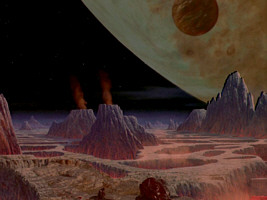
 Vulcan's moon(?) in "Star Trek I"
Vulcan's moon(?) in "Star Trek I"